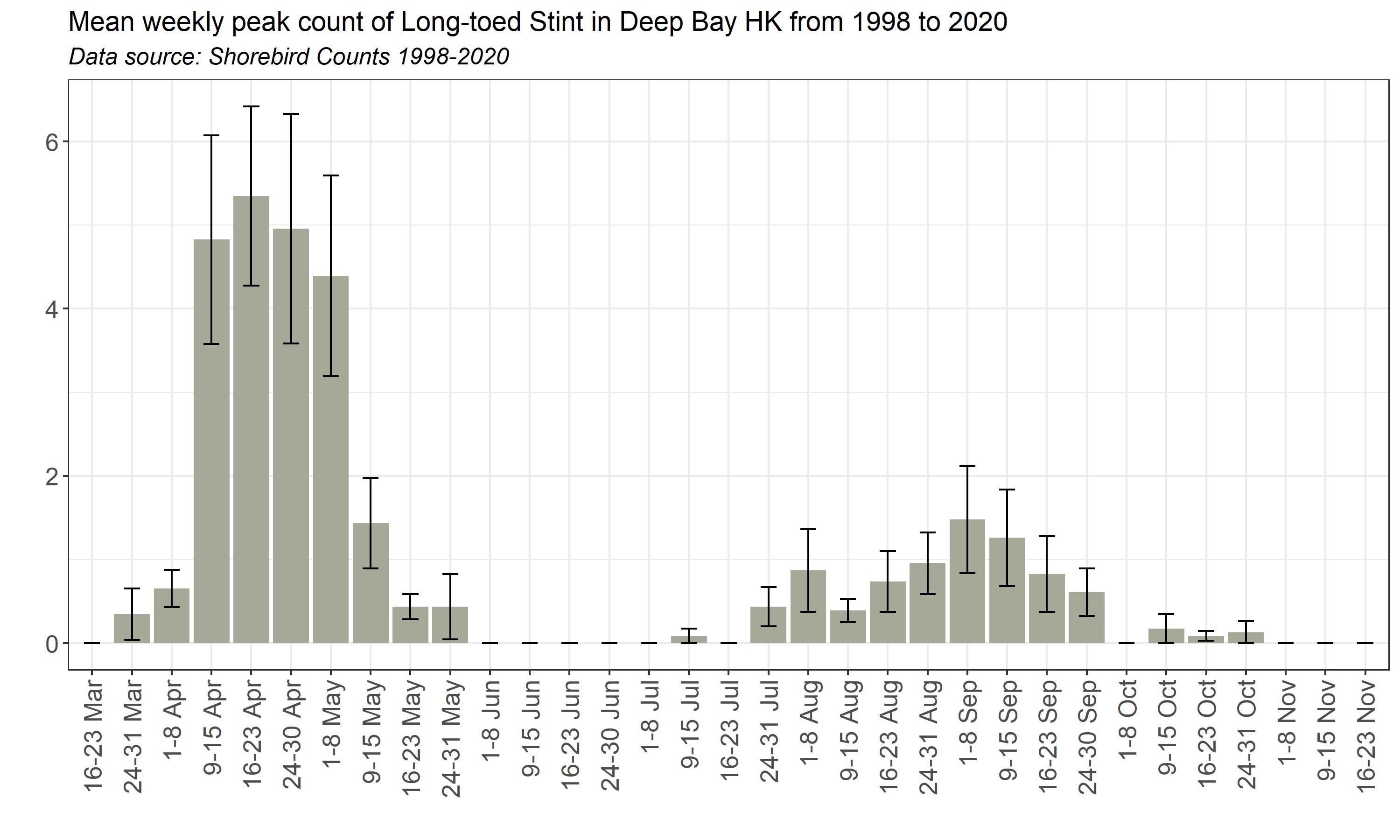Long-toed Stint Calidris subminuta 長趾濱鷸
Category I. Scarce passage migrant, rare winter visitor. Numbers appear to be in decline.
IDENTIFICATION

Apr. 2004, John and Jemi Holmes. Adult, breeding plumage.
13-16 cm. Pale-legged stint with relatively short, slightly decurved bill, long neck, small head and long toes, particularly the central one. Compared to other stints appears more elegant and holds its head low and body tipped forward when foraging.
Breeding plumage is rather bright with fairly extensive fine streaking on chest. Dark crown extends over forehead to reach bill base. Warm brown fringes to upperpart feathers and tertials in breeding plumage.

Sep. 2023, Paul Leader. Juvenile.
Juvenile similar to breeding plumage adult but not as bright generally and has whiter fringes to upperpart feathers and little warm colouration around the face and chest.

Aug. 2022, Sarawak, Malaysia. Dave Bakewell. Non-breeding plumage.
In non-breeding plumage has extensive chest streaking and darker grey-brown centres to pale-fringed upperpart feathers imparting a more streaked appearance at a distance.
VOCALISATIONS
A rolling ‘trrrt’ or a shorter ‘tert’ are the flight calls most often heard.
DISTRIBUTION & HABITAT PREFERENCE
Most records are from areas of fish ponds, wet agriculture, freshwater marsh and wet grassy areas in the New Territories, mainly in the Deep Bay area but also as far afield as Sai Kung, Lam Tsuen, Shuen Wan and on the islands of Lantau, Chek Lap Kok, Po Toi and Cheung Chau. In the 1970s there were records of up to 20 at the former airport at Kai Tak (all during autumn), with up to four there in recent years in the runway park site.
OCCURRENCE
Long-toed Stint is a passage migrant with the largest numbers occurring on northward migration (Figure 1). This commences around the middle of March, with main passage from the second week of April to the first week of May. The highest count on record is 175 on 13 April 1993 (with 120 present the previous day); the highest count this century, however, is 84 on 4 May 2011. Numbers then tail off considerably, and the highest count after the first week of May is ten. What appears to be the latest record of a passage bird concerns one on 28 May 2015 on Chek Lap Kok island. There are only two June records, in 1989 and 2018.
The earliest autumn record is 15 July 1999, and autumn passage is generally noted from the last week of July and peaks in the second half of August and the first half of September, with the highest count being 49 at San Tin on 18 September 2002. Only single figure counts have been made in October this century, whereas previously counts of up to 30 were regular.
The number of birds wintering appears to have fallen considerably (Figure 2). In the 1980s and 1990s the highest winter counts were 54 on 26 November 1993 and 50 on 18 December 1982, with double-figure counts regularly made. While the highest count this century is 36, the next highest count in the November to February period is only six.
HK lies at the northern edge of the wintering range, so the decline in number recorded is interesting as the expectation is that milder winters induced by climate change would allow more birds to spend the non-breeding season here. The availability of suitable freshwater habitat has increased, and so it would appear that, in tandem with the lower peak counts in spring and the relatively low numbers in October, the explanation may be population decrease.
Vaughan and Jones (1913) stated that Long-toed Stint was a winter visitor that occurred from 25 August to 30 April. Not recorded by Dove and Goodhart (1955), it was noted by Macfarlane and Macdonald (1966) as an occasional spring passage migrant with three records.
BEHAVIOUR, FORAGING & DIET
More than other stints, prefers to forage in lightly vegetated freshwater wetlands where it picks unobtrusively for food. Readily walks on mats of wet vegetation covering water surface. Rare on intertidal mudflats.
RANGE & SYSTEMATICS
Monotypic. Disjunct breeding populations are located in Russia east of the Urals as far as the Sea of Okhotsk and the Kuriles; winters in southeastern areas of the Indian subcontinent, around the Bay of Bengal, Indochina, southeast Asia, Indonesia and Australia, with small numbers north to Taiwan (Van Gils et al. 2020). In China a migrant through much of the country and winters along the southeast coast, including Hainan and Taiwan (Liu and Chen 2021).
CONSERVATION STATUS
IUCN: Least Concern. Population trend unknown.
Figure 1.

Figure 2.

Dove, R. S. and H. J. Goodhart (1955). Field observations from the Colony of Hong Kong. Ibis 97: 311-340.
Liu, Y. and S. H. Chen (eds) (2021). The CNG Field Guide to the Birds of China (in Chinese). Hunan Science and Technology Publication House, Changsha.
Macfarlane, A. M. and A. D. Macdonald, revised by Caunter, J. R. L. and A. M. Macfarlane (1966). An Annotated Check-list of the Birds of Hong Kong. Hong Kong Bird Watching Society, Hong Kong.
Vaughan, R. E. and K. H. Jones (1913). The birds of Hong Kong, Macao and the West River or Si Kiang in South-East China, with special reference to their nidification and seasonal movements. Ibis 1913: 17-76, 163-201, 351-384.
Van Gils, J., P. Wiersma, and G. M. Kirwan (2020). Long-toed Stint (Calidris subminuta), version 1.0. In Birds of the World (J. del Hoyo, A. Elliott, J. Sargatal, D. A. Christie, and E. de Juana, Editors). Cornell Lab of Ornithology, Ithaca, NY, USA. https://doi.org/10.2173/bow.lotsti.01

